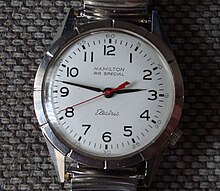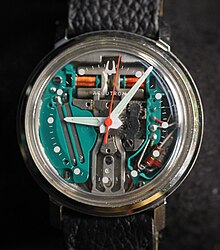| This article needs additional citations for verification. Please help improve this article by adding citations to reliable sources. Unsourced material may be challenged and removed. Find sources: "Electric watch" – news · newspapers · books · scholar · JSTOR (September 2014) (Learn how and when to remove this message) |



In horology, the term electric watch is used for the first generation electrically-powered wristwatches which were first publicly displayed by both Elgin National Watch Company and Lip on March 19, 1952, with working laboratory examples in Chicago and Paris. The Hamilton Watch Company would be the first to produce and retail an electric watch beginning in 1957, before the commercial introduction of the quartz wristwatch in 1969 by Seiko with the Astron. Their timekeeping element was either a traditional balance wheel or a tuning fork, driven electromagnetically by a solenoid powered by a battery. The hands were driven mechanically through a wheel train. They were superseded by quartz watches, which had greater accuracy and durability due to their lower parts count. Recent automatic quartz watches, which combine mechanical technology with quartz timekeeping, are not included in this classification.
Weaknesses
A weak point in early balance wheel electric watches was the switch contacts on the balance wheel, which turned the solenoid on briefly to provide the impulse to keep the wheel oscillating. These wore out and did not operate reliably. Later designs used electromagnetic sensing, with a transistor in the circuit to turn the solenoid on.
Types of electric watches
- Moving coil system, contact controlled: refers to watches with a balance wheel with integrated coil, fixed magnets and mechanical contacts. Examples of this technology are Hamilton 500 (first retail electric watch in 1957), Epperlein 100, Champion (Ruhla / UMF), Slava 114ChN and Timex M40.
- Fixed coil system, contact controlled: watches with a piece of refined iron attached to the balance wheel, a fixed coil and mechanical contacts. In order to extend the life of the watch, some of these movements included a diode to minimize sparking on the contacts. Examples of this technology are Lip electronic R 27, LIP R 148, Elgin electronic 722, 725, 910 which were the smallest electronic movements ever made and Landeron (ESA - Ebauches S.A.) 4750.
- Transistorized watches with balance: had a balance wheel, a transistor acting as a switch and no mechanical contacts. Usually the coil was located in the base plate and the magnets are on the balance wheel. Watches using this technology include Timex M87/Laco 882, Citizen X-8 series and Seiko Electronic 31A. Another common example is ESA Dynotron cal. 9150.
- Tuning fork watches: Instead of a balance wheel, these watches used a tuning fork driven by a solenoid powered by a one-transistor oscillator circuit and no mechanical contacts. The tuning fork had an attached pawl and 'index wheel', which turned the gear train. The common frequencies used in watches were 300 Hz (ESA MOSABA cal. 9162, 9164 and 9210), 360 Hz (Bulova Accutron cal. 214 and 218), Slava Transistor, Tianjin 'Yinchabiao', Prim Elton, 480 Hz (Bulova Accutron cal. 2300) and 720 Hz (Omega Megasonic cal. 1220 and 1230). Omega F300Hz and Speedsonics series are common examples of ESA MOSABA based watches.
See also
References
- Engineering time: inventing the electronic wristwatch, Carlene Stephens and Maggie Dennis, British Journal for the History of Science, Vol. 33, pp. 477–497, 2000, Cambridge University Press
- The Electric Watch Repair Manual, Henry B. Fried, 1965, B. Jadow and Sons Publishers, Library of Congress Card Number 65-18620, p.34, "ELECTRIC TIMEPIECES - HOW AND WHY THEY WORK"
- The Electric Watch Repair Manual, Henry B. Fried, 1965, B. Jadow and Sons Publishers, Library of Congress Card Number 65-18620, p.59, "SPARKING: ITS CAUSES AND CURES"
- The Electric Watch Repair Manual, Henry B. Fried, 1965, B. Jadow and Sons Publishers, Library of Congress Card Number 65-18620, p.161, "THE HAMILTON ELECTRIC WATCH"
- "The Hamilton Electric 500". Archived from the original on 2014-02-12. Retrieved 2014-09-11.
- The Electric Watch Repair Manual, Henry B. Fried, 1965, B. Jadow and Sons Publishers, Library of Congress Card Number 65-18620; p.134, "THE BENRUS ELECTRIC WATCH"; p.149, "THE ELGIN'S ELECTRIC WATCH"; p.171 "THE LIP ELECTRIC WATCH"; p.183, "THE SWISS ELECTRIC WATCH"
- "The Electronic Age". Retrieved 2014-09-11.
- The Electric Watch Repair Manual, Henry B. Fried, 1965, B. Jadow and Sons Publishers, Library of Congress Card Number 65-18620, p.103, "ACCUTRON"
- "The Accutron "Spaceview D"". Archived from the original on 2014-11-28. Retrieved 2014-09-11.